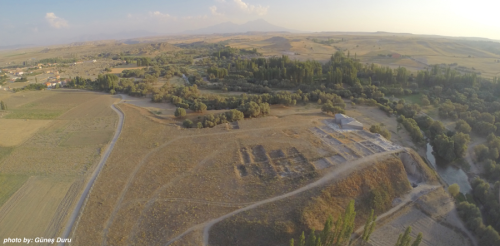
The inhabitants of Aşıklı Höyük, also known as the “earliest sedentary community of Western Cappadocia”, have managed to live together in cohesion for hundreds of years.
During this long span of time, despite slow and gradual changes manifested through population growth, increasing interaction with other regions and communities, innovations in technology, changes in burial practices, architecture, and subsistence, the Aşıklı community persisted their collective lifestyle. Aşıklı community, who lived about 10 thousand years ago, could be regarded as a guide for today’s societies to question their existence, ideologies, forms of organization and social identities.
Aşıklı Höyük Research Project stands out with a research history of 30 years, in which changing archaeological approaches and research methods have been applied. The first period of research at the site started in 1989 as a salvage excavation led by the pioneering archaeologist Prof. Ufuk Esin. Since 2006, second period of research and excavations at the site continues under the directorate of Prof. Mihriban Özbaşaran and Dr. Güneş Duru, as a multi-disciplinary and multi-national project shaped by new questions and methods. This short article that attempts to picture what life at Aşıklı was like 10.000 years ago is a product of numerous methods and disciplines, stemming from a multi-disciplinary teamwork of almost 30 years.
During the end of the 9th millennium BC, the inhabitants of Aşıklı Höyük decided to settle nearby the Melendiz River, rising from the Melendiz Mountains and flowing towards the Ihlara Valley. With its rich annual precipitation, abundant water resources, open-woodland and steppe environment the landscape provides a rich habitat for various plant and animal species. Rising from the slopes of the Melendiz Mountains, the Melendiz River creates a narrow alluvial valley to the south, west and north of Aşıklı. This rich and diverse environment could have encouraged the inhabitants for agricultural activities. The forests around the Ihlara Valley was the main source for oak trees that were used as fuel by the community and protected them from cold winter nights. The volcanic landscape rich in raw materials such as obsidian, basalt, limestone, tuff, andesite, sandstone offered the community a wide range of opportunities for manufacturing tools and objects.
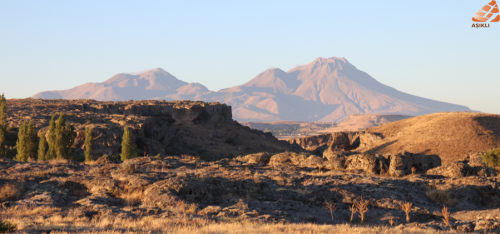
Hasan Dağ
The inhabitants organized their daily, seasonal, annual activities in cohesion with this rich environment and climatic conditions. During the earliest phases of the settlement, they spent their time in open activity areas located between oval, semi-subterranean buildings. Over the centuries, these buildings were going to be replaced by rectangular, above-ground buildings and the daily activities would be transformed onto the flat roofs of those houses. In warm and dry seasons, their main daily tasks included processing animal skin, knapping obsidian, making beads, and food preparation. Some members of the community went nearby the river and hunted fish and water birds and collected pebbles to build their hearths, while some members were busy gathering hackberries, legumes, nuts and fruits for food and different wood types for fuel. The individuals who went hunting brought the most meat-bearing parts of the hunted animals such as sheep and goat, cattle, deer, wild boar, fox and hare to the settlement. The first inhabitants of Aşıklı were broad spectrum hunter-gatherers, but at the same time, they were small scale cultivators. They have also begun to keep sheep/goat within the settlement in wattle and daub enclosures. These early experiences would eventually transform into domestication of sheep/goat and the role of agriculture would increase simultaneously over the centuries.
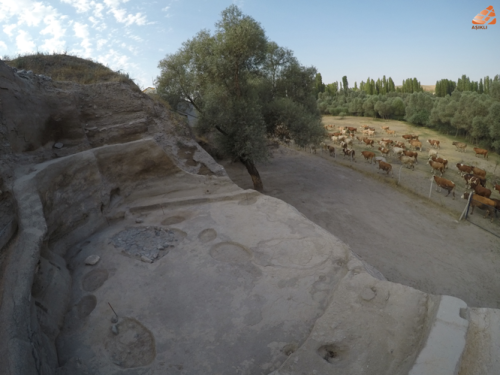
Beginnings of sedentism at Aşıklı, second half of the 9th millennium BC
The landscape provides various rocks that could as well perfectly serve as a construction material and mudbrick is not the most convenient construction material for such a region with high annual precipitation. However, it provides humidity and warmness during winters and coolness during summers inside the buildings. And the Aşıklı community used mudbrick as the main construction material throughout the occupation at the site. Sunny and dry weather should have been a good time for construction, maintenance and repairment activities at the mudbrick buildings. In these periods of the year, mudbricks were made with pisé and mostly mold techniques, using dung and various plants as temper and binder material. The prepared blocks were then dried under the sun. Spring and summer months with fewer rains should have also been a good time for long distance visits. The obsidian sources at a distance of about 40 km were the center of a wide exchange network from Cyprus to Southwest Asia. Knappers from Aşıklı also procured obsidian from these sources. After giving the preform to the obsidian blocks at the source, they brought these to the settlement, and turned them into tools at the end of a complex production sequence. Although the types, sizes, and functions of these tools have gradually changed and diversified over centuries in accordance with the inhabitants’ needs, know-how and skills, these tools were always the products that facilitated the daily life. Similarly, fragments of ignimbrites, a volcanic rock, were collected at the source, shaped at the spot, and then brought to the settlement (usually in the 8th millennium BC life) to enclose the hearths.
In November and December, the weather cools down thoroughly and brings snow to the region. Consequently, the daily life which was conducted on the roof level or in open spaces in warm seasons should have had continued inside the buildings during winter seasons. These periods of the year was probably the time when the stress of living together increased the most. Aşıklı community, who exhibits strict characteristics of a collective way-of-life, lived together—probably in large groups—in the oval, semi-subterranean buildings during the earlier phases of the settlement. In the following centuries, the community, which then began to grow into a larger population, continued to live together inside the single-roomed or multi-roomed rectangular buildings. The main activity area was around the hearth inside the rooms, and hearth-related activities were not limited to cooking and food preparation. At the same time, fireplaces were possibly a medium of creating social spaces where people came together for conversations, sharing experiences, and telling stories.
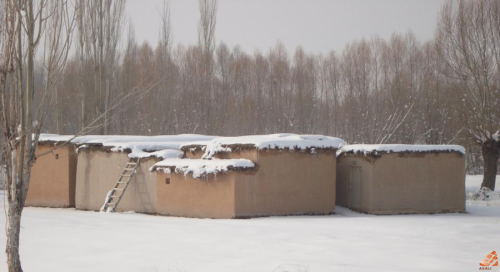
“Village life” during the 8th millennium BC (Experimental Aşıklı Houses)
By the 8th millennium BC, the life at Aşıklı became similar to today’s village life; the settlement pattern consisted of building groups that formed neighborhoods separated by narrow passages and streets. The buildings were renewed in approximately every 50 years. In renewal activities, a new building was constructed directly on the base of the former building, without changing its plan, size nor the location of the internal features. Simultaneous with these changes, a special purposed buildings area was constructed to the south of the settlement. A large gravel street separated this area from the dwellings. One of the buildings in this area had yellow and red painted floors and walls, a bench, and a canal extending out of the building. Another building differs from the dwellings due to its north wall which is built with stones, and its inner space that paved with mudbricks and probably served as a courtyard. Its floor was renewed 300 times; this further attests to the repeated use and significance of the building. Large amounts of cattle meat was consumed in the open space located in this area. Further significance of this area stems from a painted platform on which cattle bones were placed, communal ovens, and tandouries that are not known from any other area within the settlement. This part of the settlement was organized for activities that involved collective food consumption, feasting and rituals that brought the people together outside the “home”.
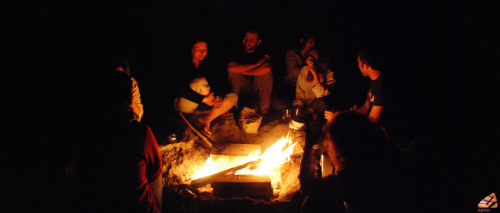
A series of actions such as deciding the time for the construction activities, obtaining and transportating the soil into the settlement, choosing the binder and the temper for the right recipe of mudbricks, mixing the mudbrick, plastering floors and walls, dangerous works such as burning the lime, transporting the wood for lime production were all results of a complex organization of the division of labor. Similarly, collective food consumption, feasting and rituals that took place at the special purposed buildings area carrying large animals into the settlement, and organization of daily, seasonal and annual activities were also related to the social cohesion and solidarity that the Aşıklı community managed to maintain over hundreds of years. Moreover, situations that caused an unexpected social stress should come to exist where serious and rapid decisions should have been taken, such as sickness and death.
Perhaps the most crucial dimension of such a division of labor and social organization was the leadership and decision-making processes. It is understood through multiple lines of evidence that at Aşıklı the process of decision-making was carried out collectively by all members of the community and for centuries this rule was not subject to any exceptions. It could be suggested that some individuals, in terms of their age, knowledge, experience and skill stood out in certain moments of decision-making for establishing a common ground among the members of the community. These instances could include deciding when to go out for hunting, how to redistribute the meat from the hunt and such a process may have been guided by the experienced hunters. As a matter of fact, during the period when the “village life” was established at Aşıklı, some social roles and groups started to become evident. However, these initial diversities in social roles and identities at Aşıklı was never became the dominant fabric of the community. Similarly, there are no signs indicating a gendered perception of personhood of behaviors and relations based on domination.
The rich landscape that triggered mobility among the members and groups of the sedentary hunter-gatherer Aşıklı community should have brought the need of problem-solving and decision-making mechanisms together with the possible social stresses stemming from the complex organization of the year-round habitation at the site. Through time, this necessity was solved with a non-strict organization at the household level, which turned into a social strategy for maintaining the social cohesion. This social organization, which was possible by a constant renewal of social relations, should have been based on the principle of reciprocity, despite some changes within time. Collective fabric of the community was not only an action, but a mediator that regulated both the human-environment and the human-community relationships at Aşıklı. This harmony should have depended on the continuity of sharing, the main principal of their social organization mechanisms. Sharing the food, tools, objects, knowledge, and experience was carried out within certain rules, in a modest manner among the members of the community. The inhabitants had been able to transfer their tools, labour, knowledge, and experience for almost 35 generations. Despite the complexity of the production and organization processes and the consequent division of labor, no indications of competition are evident. The overall social structure should have been the main parameter that prevented the power to be attained by a person or group within the Aşıklı community.
This lifestyle and motivation of the inhabitants of Aşıklı, who lived 10.000 years ago, is still whispired today to anyone who is ready to listen: “another world is possible”.
Photos: Aşıklı Höyük Excavation and Research Project Archive

